Sprinkles. Jimmies. Hundreds and thousands. Nonpareils. Cachous. Sanding sugar... There are so many different types of sprinkles out there. Which one is which? And how is "cachous" pronounced anyway?
An ice cream without sprinkles is unthinkable! A cupcake without hundreds and thousands? A diet cupcake! With so many different types of sprinkle out there, it can be confusing navigating this sweet world. Luckily, we got you! Here is the be all and end all of sprinkles...
Pronounced like the nut: cashews
You know these! They are those round little ball bearings, usually metallic. They often were silver, but now there are many different colours available. Their sizes range from 3mm diameter to 8mm or even 10mm.
Use sparingly, sprinkled on icings and cookies, as they are a bit hard on the teeth sometimes! Black cachous can be used as eyes in figurines, and red ones make great holly berries at Christmas time.
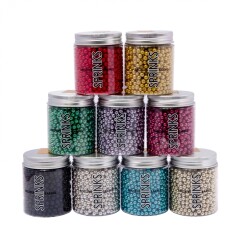
Pronounced: drah-shaay
Generally bigger than cachous, and in different shapes than just round. Sometimes they are sugar coated chocolate shapes. Some countries use this term for cachous as well.
As they are quite large, they can be a "statement" decoration on your cupcake.
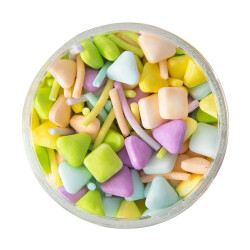
Mostly a term used in the UK. These are the multi coloured tiny, weeny balls that are used on fairy bread. They are essentially a very small cachou. Also called micro sprinkles.
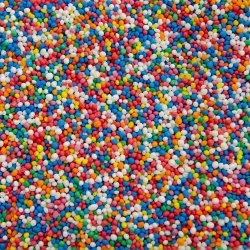
Long, cylindrical strands of coloured sugary goodness. Generally what sprinkles are called the in the USA.
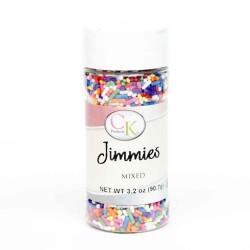
Australian term for the thin strands of multicoloured sugary goodness. They are much thinner than jimmies.
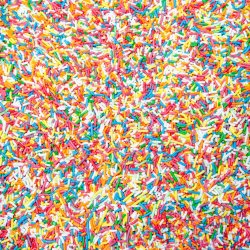
Pronunciation is tricky. It depends if you want to say it the French way (non puh-ray) the American way (non puh-rayl) or the "English" way (non pah-rels). Here at Lollipops, we'll know what you mean no matter how you say it!
These are the tiny little balls that can come in an assortment of bright colours, as well as in metallics. They are absolutely adorable sprinkled on a cupcake swirl, or mixed with larger cachous and jimmies to create a sprinkle mix.
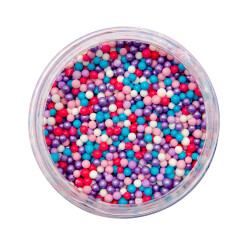
Chocolate filled balls with a coloured sugar shell. Usually 10mm and bigger.
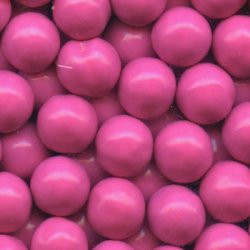
Pronunciation: verm-mee-selly
British term for "sprinkles" but mostly the chocolate ones.
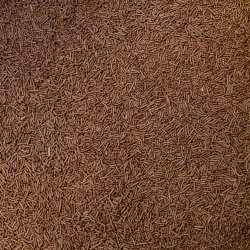
Coloured sugar that does not melt as easily as regular sugar. Looks quite glittery.
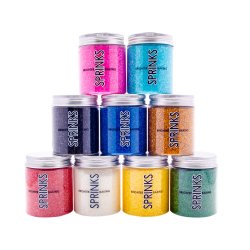
Multi coloured flat discs or shapes. Also called quins or sequins in the USA. They can also come in fun seasonable shapes like pumpkins, Christmas trees and hearts.
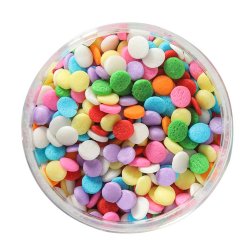
A small strand of spaghetti covered in sugar and coloured. Essentially a type of dragée. They can be a choking hazard due to their shape so remove from the treat before giving to children.
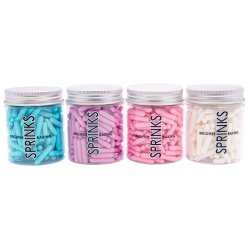
Delicious little morsels or crispy biscuit, encased in Belgian chocolate. They come in dark, milk, white and caramel chocolate. The ultimate grown up, luxurious sprinkle!
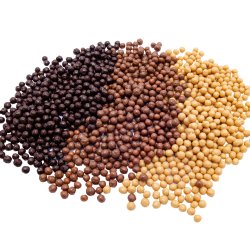
You can use the confetti and jimmies in baked goods as the colour does not bleed as readily as nonpareils or sprinkles.
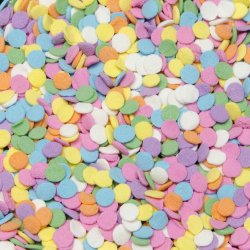

Sprinkle mixes are where it gets exciting! There are multi coloured blends of any of the above styles of sprinkles, created to be able to suit any style of baking that you may be doing. They are often themed, and some have fun wafer paper or royal icing pieces in them. We have a variety of different brands of sprinkle mixes available, so how do you know what makes them different from each other?
These sprinkle mixes are a lower price point, perfect for the casual baker or person that only dabbles in baking infrequently. They usually consist of a blend of jimmies, cachous and sanding sugar. Some also contain the larger sugar shapes or confetti as well, mixed in a way that fits the theme and style.
These deluxe nonpareil blends are hand dyed and mixed in Australia. Some mixes have the added touch of bling with some metallic cachous mixed through as well. These are very trendy, and because they are generally smaller sprinkles mixed together, are great as a subtle addition where your baked goods just need a few sprinkles to tie together the final design.
These blends get a little bit exciting, with larger jars that are jam-packed full of assorted sprinkles, they can contain a mixture of any of the jimmies, cachous, rods, sanding sugar, confetti, sugar shapes and choco balls. They come in a huge 125g jar, making them the biggest containers (apart from the larger bulk bags) of sprinkles that we stock. Imported all the way from Ireland, you'd be hard pressed to find another local stockist. With so many gorgeous mixes, it's not a question of "do I get one?" but rather, "how many should I get?".
Another imported sprinkle blend, these colourful, fantastic mixes travel all the way from the USA. Sprinkle Pop mixes stand out for their vibrant and dazzling colours, and their fun themes! From bees, to sharks, dinosaurs and rainbows, Easter and Christmas, right through to Halloween there's nothing that these guys haven't thought of. In a similar fashion to the above sprinkle mixes, they contain assortments including jimmies, sanding sugar, nonpareils, rods and choco balls. What makes these the more deluxe option however, is their inclusion of hand-piped royal icing details, and wafer paper prints. With all of these aspects, your baking is sure to knock everyone's socks off!
That's no problem at all! What you can always do is mix solid colour sprinkles together to make your own, or dye sprinkles yourself to suit.
We suggest using the Roberts nonpareils, CK Jimmies or the Sprinks cachous in complimentary colours and pouring into a bowl or container to mix together, so you can get a colour scheme that works for your baking.
If you still can't find anything, dying your own sprinkles is a piece of cake. All you need to get started is white nonpareils and/or cachous, food colouring (we recommend Colour Mill for this), a snap lock bag, some baking paper and an oven. Simply pour the amount of nonpareils you'd like to dye into the snap lock bag, add a few drops of colour, close the bagand massage and mix it until all the sprinkles are coated. Add more colour and repeat until you get the shade you desire, then simply pop on a baking paper lined tray, and put them in the oven on a very low heat (~50C) until they no longer feel wet or sticky. Voila - custom coloured sprinkles!
You can make metallic ones this way too. Mix some lustre powder with rose spirit, add to a bag of sprinkles like above (you can use any colour sprinkles), and then pour out onto a flat tray to let them dry.